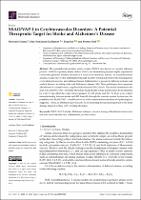| dc.contributor | Vall d'Hebron Barcelona Hospital Campus |
| dc.contributor.author | Unzeta, Mercedes |
| dc.contributor.author | Hernandez Guillamon, Maria Mar |
| dc.contributor.author | Sun, Ping |
| dc.contributor.author | Solé Piñol, Montserrat |
| dc.date.accessioned | 2022-03-21T09:14:38Z |
| dc.date.available | 2022-03-21T09:14:38Z |
| dc.date.issued | 2021-04 |
| dc.identifier.citation | Unzeta M, Hernàndez-Guillamon M, Sun P, Solé M. SSAO/VAP-1 in Cerebrovascular Disorders: A Potential Therapeutic Target for Stroke and Alzheimer’s Disease. Int J Mol Sci. 2021 Apr;22(7):3365. |
| dc.identifier.issn | 1422-0067 |
| dc.identifier.uri | https://hdl.handle.net/11351/7221 |
| dc.description | Malaltia d'Alzheimer; Inflamació; Lesions vasculars |
| dc.description.sponsorship | This research received no external funding. The Neurovascular Research Laboratory is part of the INVICTUS+ network, ISCIII, Spain (RD16/0019/0021). |
| dc.language.iso | eng |
| dc.publisher | MDPI |
| dc.relation.ispartofseries | International Journal of Molecular Sciences;22(7) |
| dc.rights | Attribution 4.0 International |
| dc.rights.uri | http://creativecommons.org/licenses/by/4.0/ |
| dc.source | Scientia |
| dc.subject | Malalties cerebrovasculars - Tractament |
| dc.subject | Amino oxidases - Metabolisme |
| dc.subject.mesh | Cerebrovascular Disorders |
| dc.subject.mesh | /therapy |
| dc.subject.mesh | Amine Oxidase (Copper-Containing) |
| dc.subject.mesh | /metabolism |
| dc.title | SSAO/VAP-1 in Cerebrovascular Disorders: A Potential Therapeutic Target for Stroke and Alzheimer’s Disease |
| dc.type | info:eu-repo/semantics/article |
| dc.identifier.doi | 10.3390/ijms22073365 |
| dc.subject.decs | trastornos cerebrovasculares |
| dc.subject.decs | /terapia |
| dc.subject.decs | amina oxidasa (con cobre) |
| dc.subject.decs | /metabolismo |
| dc.relation.publishversion | https://doi.org/10.3390/ijms22073365 |
| dc.type.version | info:eu-repo/semantics/publishedVersion |
| dc.audience | Professionals |
| dc.contributor.organismes | Institut Català de la Salut |
| dc.contributor.authoraffiliation | [Unzeta M] Departament de Bioquímica i Biologia Molecular, Institut de Neurociències, Universitat Autònoma de Barcelona, Bellaterra, Spain. [Hernàndez-Guillamon M, Solé M] Laboratori de Recerca Neurovascular, Vall d’Hebron Institut de Recerca (VHIR), Barcelona, Spain. Universitat Autònoma de Barcelona, Bellaterra, Spain. [Sun P] Department of Neurology, Pittsburgh Institute of Brain Disorders and Recovery, University of Pittsburgh School of Medicine, Pittsburgh, PA 15213, USA |
| dc.identifier.pmid | 33805974 |
| dc.identifier.wos | 000638622300001 |
| dc.relation.projectid | info:eu-repo/grantAgreement/ES/PE2013-2016/RD16%2F0019%2F0021 |
| dc.rights.accessrights | info:eu-repo/semantics/openAccess |

